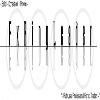Edit Your Comment
Entry Efficiency
会员从Jul 21, 2011开始
9帖子
Nov 29, 2011 at 14:33
会员从Jul 21, 2011开始
9帖子
Hey everyone,
I've done six years worth of strategy research and program trading strategies for a living. In that time, I've coded thousands of strategies and seen a number of strategies with genuine exit efficiencies.
Despite all that experience, I've never seen a strategy produce a consistent entry efficiency above 55% (i.e., random). Does anyone out there have a strategy that produces a real entry efficiency? I don't mean this in the sense of profitability - I mean it in the sense of the entry efficiency graphs that come with NinjaTrader and/or TradeStation. I'd be happy to trade ideas if you have some insight.
I've done six years worth of strategy research and program trading strategies for a living. In that time, I've coded thousands of strategies and seen a number of strategies with genuine exit efficiencies.
Despite all that experience, I've never seen a strategy produce a consistent entry efficiency above 55% (i.e., random). Does anyone out there have a strategy that produces a real entry efficiency? I don't mean this in the sense of profitability - I mean it in the sense of the entry efficiency graphs that come with NinjaTrader and/or TradeStation. I'd be happy to trade ideas if you have some insight.

forex_trader_28881
会员从Feb 07, 2011开始
691帖子
Nov 29, 2011 at 17:49
会员从Feb 07, 2011开始
691帖子
Please define "exit efficiencies".
To me it sounds like you you're saying you have a good strategy for getting out.
If that is the case then the entry is easy. It's any point. Take eurusd for example. 1.3344, run that left for a year's data, see how many times price goes through that level. 11? 20? 100?
So then the exits be the same. There is no efficiency.
Doesn't really matter what point you take, it will be crossed many times and can be used as both exit or entry.
To me it sounds like you you're saying you have a good strategy for getting out.
If that is the case then the entry is easy. It's any point. Take eurusd for example. 1.3344, run that left for a year's data, see how many times price goes through that level. 11? 20? 100?
So then the exits be the same. There is no efficiency.
Doesn't really matter what point you take, it will be crossed many times and can be used as both exit or entry.
会员从Jul 21, 2011开始
9帖子
Nov 29, 2011 at 18:23
会员从Jul 21, 2011开始
9帖子
This link explains the idea of measuring entry and exit efficiency:
https://www.ninjatrader.com/support/helpGuides/nt7/efficiency_graphs.htm
https://www.ninjatrader.com/support/helpGuides/nt7/efficiency_graphs.htm
会员从Dec 01, 2011开始
92帖子
Dec 08, 2011 at 04:13
会员从Dec 01, 2011开始
92帖子
Does no matter were you get in at there really is no such thing as a perfect entry.., just be correct on the direction of the trend.
Trying to Find the perfect entry "Picking tops and bottoms. is a pain and not worth the amount of missed good trades you will have because you missed the entry by 5 pips trying to get the perfect entry.
Trying to Find the perfect entry "Picking tops and bottoms. is a pain and not worth the amount of missed good trades you will have because you missed the entry by 5 pips trying to get the perfect entry.
会员从Jul 21, 2011开始
9帖子
Dec 09, 2011 at 09:08
会员从Jun 07, 2011开始
7帖子
ShaunOverton posted:
This link explains the idea of measuring entry and exit efficiency:
https://www.ninjatrader.com/support/helpGuides/nt7/efficiency_graphs.htm
IMHO this definition of efficiency has some flaws. E.g. the trade that makes 100 pips in 150 pips interval will be considered less efficient than trade that make 10 pips in 12 pips interval. Optimisation of such efficiency will lead to sub second timeframes and single tick profits.
Concerning entries being less "efficient" than exits, calculate it not using the time of the trade itself, but 1 time unit before and after the trade. I am pretty sure that you will get very different results.
会员从Jul 21, 2011开始
9帖子
Dec 09, 2011 at 13:14
会员从Jul 21, 2011开始
9帖子
yg10 posted:
ShaunOverton posted:
This link explains the idea of measuring entry and exit efficiency:
https://www.ninjatrader.com/support/helpGuides/nt7/efficiency_graphs.htm
IMHO this definition of efficiency has some flaws. E.g. the trade that makes 100 pips in 150 pips interval will be considered less efficient than trade that make 10 pips in 12 pips interval. Optimisation of such efficiency will lead to sub second timeframes and single tick profits.
Concerning entries being less "efficient" than exits, calculate it not using the time of the trade itself, but 1 time unit before and after the trade. I am pretty sure that you will get very different results.
Hi yg10,
Thanks for your reply. I think that you might have misunderstood the definition.
The entry efficiency is not a measure of how many pips the trade makes. It's a measure of where the entry occurs within the trades' open window. So if a long entry occurs at 50 and the lowest point was 40 and the highest point was 100, then the entry efficiency is:
(100-50)
/
100-40
= 83% entry efficiency
The scaling that you mentioned is an issue, albeit for a different reason. Measuring the efficiencies of trades that are only open for a handful of bars is of limited use; it introduces a great deal of error into the process.
Efficiencies hold true on any time frame. It's the reason that they are so useful.
会员从Jul 21, 2011开始
9帖子
Dec 09, 2011 at 18:46
会员从Jul 21, 2011开始
9帖子
I wrote this blog post to explain the idea better:
https://www.onestepremoved.com/backtesting-efficiency/
https://www.onestepremoved.com/backtesting-efficiency/
Dec 11, 2011 at 02:05
会员从Jun 07, 2011开始
7帖子
ShaunOverton posted:
yg10 posted:
ShaunOverton posted:
This link explains the idea of measuring entry and exit efficiency:
https://www.ninjatrader.com/support/helpGuides/nt7/efficiency_graphs.htm
IMHO this definition of efficiency has some flaws. E.g. the trade that makes 100 pips in 150 pips interval will be considered less efficient than trade that make 10 pips in 12 pips interval. Optimisation of such efficiency will lead to sub second timeframes and single tick profits.
Concerning entries being less "efficient" than exits, calculate it not using the time of the trade itself, but 1 time unit before and after the trade. I am pretty sure that you will get very different results.
Hi yg10,
Thanks for your reply. I think that you might have misunderstood the definition.
The entry efficiency is not a measure of how many pips the trade makes. It's a measure of where the entry occurs within the trades' open window. So if a long entry occurs at 50 and the lowest point was 40 and the highest point was 100, then the entry efficiency is:
(100-50)
/
100-40
= 83% entry efficiency
That was my point: this definition of efficiency is limited to original trades' window and overshadows absolute gain.
The scaling that you mentioned is an issue, albeit for a different reason. Measuring the efficiencies of trades that are only open for a handful of bars is of limited use; it introduces a great deal of error into the process.
I did not mention scaling. I said that optimisation of this efficiency will decrease the duration of trade. Can you also please give a definition of "handful of bars"?
Efficiencies hold true on any time frame. It's the reason that they are so useful.
Again, I never mentioned any particular time frame. I recommended to calculate this efficiency outside the original trades' window. This will also help to understand that with this definition of efficiency exits always will more effective than entries.
Concerning usefulness, IMHO this definition of efficiency might be useful for system sellers but is almost of no use for those who trade for profit.

*商业用途和垃圾邮件将不被容忍,并可能导致账户终止。
提示:发布图片/YouTube网址会自动嵌入到您的帖子中!
提示:键入@符号,自动完成参与此讨论的用户名。












